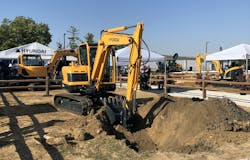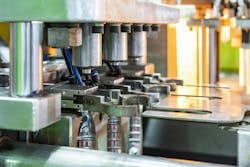What do the Next 75 Years Have in Store for Hydraulic and Pneumatic Systems?
Over the past 75 years, the fluid power industry has continued to evolve. While the principles of hydraulics and pneumatics have not changed during this time, shifting customer requirements and technological advancements have brought new components and systems to market.
With these technology developments have come new capabilities, application uses and more.
And Power & Motion has been there to cover it all.
As noted in an article earlier this year, 2023 is Power & Motion's 75th anniversary and throughout the publication's history - and multiple name changes - there has been a strong focus on the hydraulic and pneumatic technologies helping to put the world in motion. This remains the case today even as electrification and other market trends bring new design needs and technologies into the motion control space.
In honor of Power & Motion's 75th anniversary, our team has been looking through some of the archives to get a sense of where the industry has come from (stay tuned for more on that in November!) but what about the future? What might the next 75 years have in store for hydraulic and pneumatic systems?
What is the Future of Fluid Power?
I've written it several times before, but we continue to hear how it is an exciting time for the fluid power industry. Yes, the growing use of electrification and automation are bringing new design challenges to the industry - and in some cases even leading to use of electronic technologies in place of hydraulics and pneumatics - but these and other industry trends are also bringing about new opportunities.
Electrification, for instance, is requiring development of systems which are more energy efficient. This is enabling engineering teams to rethink system architectures and component designs. Integration of more electronics into hydraulics and pneumatics is aiding with their precision and efficiency as well.
The National Fluid Power Association's (NFPA) 2023 Technology Roadmap outlines a number of areas in which the industry could focus its development efforts to meet evolving customer requirements, demonstrating the many design opportunities yet possible.
Increasing the power density of hydraulic and pneumatic components, reducing their environmental impact, and improving the ability to monitor or use data from fluid power systems were just some of the capability improvements noted by in the roadmap. These offer several new design opportunities for the industry.
READ MORE: Assessing Future Design Needs for Hydraulics and Pneumatics
Although electronic options are displacing hydraulic and pneumatic components in some applications, there are many where fluid power motion technologies will remain integral. Construction equipment and other heavy-duty mobile machines, for example, will continue to rely on hydraulics for many years even as the off-road equipment industry transitions to electrification.
In especially large machines, electronic options can not yet provide the force hydraulics can. Additionally, operators are used to maintaining and working with hydraulics so many OEMs want to keep them in their machines so there is familiarity and therefore an easier transition to electric machines.
Continued investments in infrastructure and reshoring in the coming years will create ongoing demand for heavy equipment and thus the hydraulic components which they rely on.
For pneumatics, increasing adoption of robotics presents an opportunity. Here again electronic options are gaining ground, but pneumatics still offer a cost-effective solution for robotic grippers and other aspects of a robot. Integration of electronics with pneumatics is helping to make them more precise and increase their capabilities in these and other applications.
READ MORE: Robots and Cobots Present Opportunity for Pneumatics
It's hard to predict what the next 75 years will bring for the fluid power industry, but given the continued benefits offered by hydraulics and pneumatics as well as the many design opportunities still possible with these technologies, it's clear there remains a long road ahead for fluid power motion solutions.
We want to hear from you!
What do you think will be the biggest changes which occur in the fluid power industry in the coming decades? How have you seen hydraulic and pneumatic technologies evolve, and what further evolutions are possible?
Email me at [email protected] or reach out to us on social media.
X (formerly Twitter): @TechnlgyEditor or @PowerMotionTech
LinkedIn: @PowerMotionTech
About the Author
Sara Jensen
Executive Editor, Power & Motion
Sara Jensen is executive editor of Power & Motion, directing expanded coverage into the modern fluid power space, as well as mechatronic and smart technologies. She has over 15 years of publishing experience. Prior to Power & Motion she spent 11 years with a trade publication for engineers of heavy-duty equipment, the last 3 of which were as the editor and brand lead. Over the course of her time in the B2B industry, Sara has gained an extensive knowledge of various heavy-duty equipment industries — including construction, agriculture, mining and on-road trucks —along with the systems and market trends which impact them such as fluid power and electronic motion control technologies.
You can follow Sara and Power & Motion via the following social media handles:
X (formerly Twitter): @TechnlgyEditor and @PowerMotionTech
LinkedIn: @SaraJensen and @Power&Motion
Facebook: @PowerMotionTech

Leaders relevant to this article:



